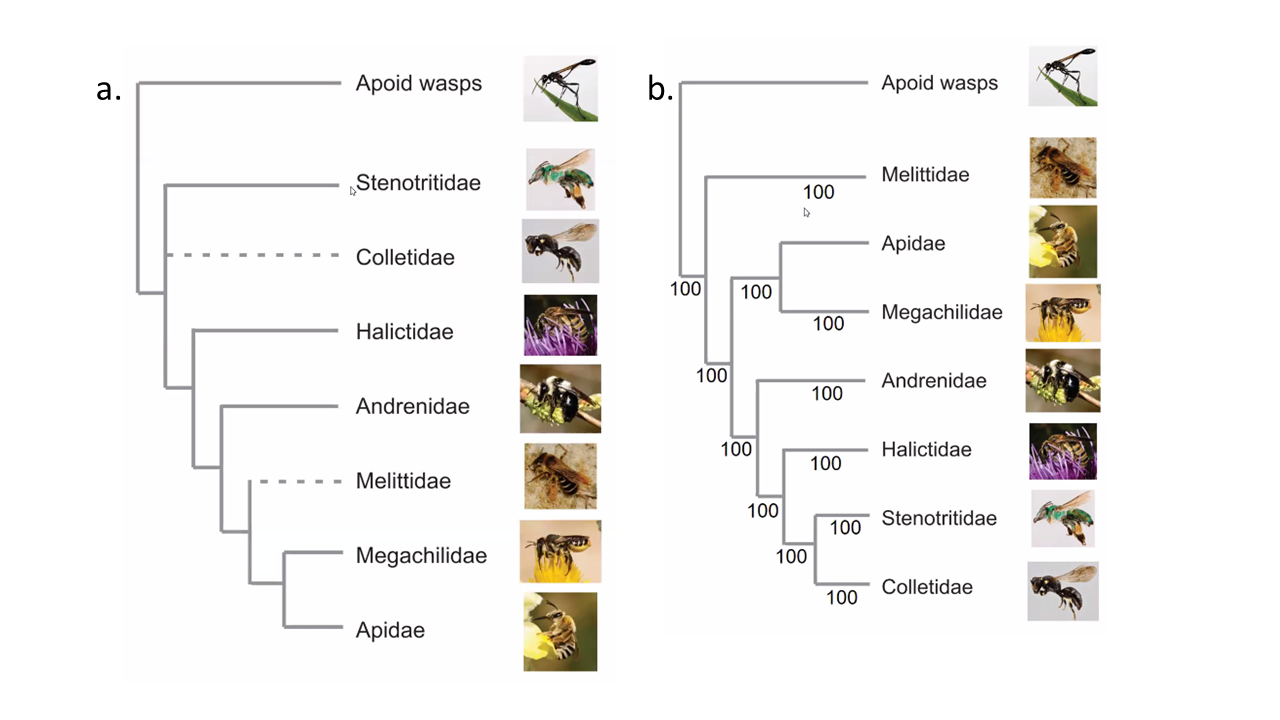|
written by: Taís Ribeiro and Darsy Smith Have you ever thought about how scientists know how organisms are related? Similar to how humans can use family trees to know who are their relatives, scientists can study the relationship between groups of organisms by constructing phylogenetic trees. These phylogenetic trees are two-dimensional diagrams that can represent the evolution and diversification of a group of organisms (Figure 1). Phylogenetic trees can show what organisms are in the base (or the root) of a tree, and more closely related groups in closer branches. Phylogenetic relationships help us understand the diversity of species and address ecological and evolutionary questions. Traditionally phylogenies were constructed using morphological data – what organisms look like—but advances in molecular phylogenetics, first with a few genetic markers and now with phylogenomic studies that use hundreds of genes, have transformed our understanding of these biological questions. In the University of Maryland’s Entomology seminar series, we had the opportunity to learn about phylogenetic studies with Dr. Bryan Danforth, a professor at Cornell University whose research focuses on bee biology and evolution. The collaborative work between scientists - including graduate students - propelled our understanding of bee evolution. In his talk, Dr. Danforth discussed how advances in molecular phylogenetics contribute to the understanding of bee life history and behavior. Who are the bees’ relatives? Bees are in the order Hymenoptera along with wasps and ants, and are often described as “vegetarian fuzzy wasps”, because unlike many carnivorous wasps they are pollen-eating wasps with feathery hairs to collect pollen. But how did some wasps become vegetarian? To answer this, we have to look at the evolutionary relationships within this group. In the traditional morphological phylogeny of bees and closely related wasps, bees were placed in a branch closely related to the wasp family Crabronidae. However, in more advanced molecular phylogenetics, bees were consistently appearing inside the Crabronidae branch (Sann et al 2017). These phylogenies showed that bees share many genetic similarities with a group of wasps that eat thrips, which are pollen-eating insects. This suggests that bees might have evolved the ability to eat pollen by eating these thrips covered in pollen. This switch from eating prey to eating pollen could be responsible for the explosion in the diversification of bees that we see now, with seven diverse bee families. How are all bees related? Now that we know where the bees stand in Hymenoptera, the next step is to understand the relationships between the seven bee families. These relationships can be quite different when looking at a morphological or a molecular phylogeny. Dr. Danforth and his lab are interested in learning about the relationship among all seven bee families using molecular data. Early in the 1990s, the morphological phylogeny of bees placed the family Colletidae, a group that includes plasterer bees, at the base of the tree. This was probably because of their bilobed short tongue, that could be similar to the tongue in some wasps. However, Dr. Danforth and collaborators reconstructed the phylogeny of bees using from five to 800 nuclear genes and found different results (Branstetter et al 2017). Instead of Colletidae at the base of the tree, these reconstructions show Melittidae, a family of plant-specialists picky eater bees, at the base (Figure 2). This result could be also used to make inferences on the host-plant use, indicating that the ancestral of bees was a specialist rather than a generalist and the evolution of the generalist trait could be related to the bee diversity. It also could indicate that the tongue in Colletidae is a unique trait rather than a similarity with wasps. How did brood parasite bees evolve? Apart from the relationships with host plants, bees can have a different kind of hosts: the nests of other bees. There are brood parasitic bees, or “cuckoo bees”, who lay their eggs in the nests of a different bee species so that instead of collecting and providing for their larvae, they can feed on the pollen that their host carefully prepared for their own offspring. Recent studies in the Danforth lab concluded that these brood parasites belong to a single clade separated from the host (Cardinal & Danforth 2010, Bossert et al 2017) but started by preferring hosts that are closed related before evolving to use hosts from a wide array of families (Sless et al 2021). How did bees become social? Contrary to popular belief, most bee species are solitary. But the most famous groups are social bees in the family Apidae – the groups that include honeybees (Apini), bumblebees (Bombini), and stingless bees (Meliponini). But even though those are the most studied bees, the relationship among these groups and the origin of sociality is still controversial. Dr. Danforth used phylogenetics to learn about the origin of social behavior in these groups. According to the early morphological phylogeny, the evolution of sociality started with a solitary common ancestor, then to the primitive eusociality in bumblebees, and one single origin for advanced sociality (Figure 3a). After several inconclusive studies including molecular data and other analyses, Dr. Danforth’s student used more advanced molecular data and found that the advanced eusociality evolved twice (Figure 3b). This suggests that advanced eusociality evolved independently in honeybees and stingless bees. Dr. Danforth is invested in sharing knowledge about bees. He has recently published an instant classic book on solitary bee biology and he is also one of the organizers of the Bee Course, an intensive workshop for people interested in understanding the biology and taxonomy of bees. Currently, the Danforth lab is focusing on analyzing the microbial composition in nests in different solitary bee groups. Phylogenetic studies can answer several ecological and evolutionary questions, like the ones regarding life history and behavior discussed here, but these methods can enhance our understanding of the evolution of many other questions, not only in bees but any other organisms.
Authors Taís Ribeiro is a third-year PhD student in the EspindoLab working on the ecology and evolution of oil-collecting bees from the genus Chalepogenus. Darsy Smith is a PhD student in the Lamp lab studying host plant resistance and reproduction of natural enemies in alfalfa ecosystems. References Alexander, B.A., Michener, C.D. (1995). Phylogenetic studies of the families of short-tongued bees (Hymenoptera:Apoidea). Univ. Kansas Sci. Bull. 55, 377–424. Branstetter, M. G., Danforth, B. N., Pitts, J. P., Faircloth, B. C., Ward, P. S., Buffington, M. L., ... & Brady, S. G. (2017). Phylogenomic insights into the evolution of stinging wasps and the origins of ants and bees. Current Biology, 27(7), 1019-1025. Bossert, S., Murray, E. A., Blaimer, B. B., & Danforth, B. N. (2017). The impact of GC bias on phylogenetic accuracy using targeted enrichment phylogenomic data. Molecular phylogenetics and evolution, 111, 149-157. Cardinal, S., Straka, J., & Danforth, B. N. (2010). Comprehensive phylogeny of apid bees reveals the evolutionary origins and antiquity of cleptoparasitism. Proceedings of the National Academy of Sciences, 107(37), 16207-16211. Sann, M., Niehuis, O., Peters, R. S., Mayer, C., Kozlov, A., Podsiadlowski, L., ... & Ohl, M. (2018). Phylogenomic analysis of Apoidea sheds new light on the sister group of bees. BMC evolutionary biology, 18(1), 1-15. Sless, T. J., Branstetter, M. G., Gillung, J. P., Krichilsky, E. A., Tobin, K. B., Straka, J., ... & Danforth, B. N. (2022). Phylogenetic relationships and the evolution of host preferences in the largest clade of brood parasitic bees (Apidae: Nomadinae). Molecular Phylogenetics and Evolution, 166, 107326. Comments are closed.
|
Categories
All
Archives
June 2024
|
Department of Entomology
University of Maryland
4112 Plant Sciences Building
College Park, MD 20742-4454
USA
Telephone: 301.405.3911
Fax: 301.314.9290
University of Maryland
4112 Plant Sciences Building
College Park, MD 20742-4454
USA
Telephone: 301.405.3911
Fax: 301.314.9290




 RSS Feed
RSS Feed




